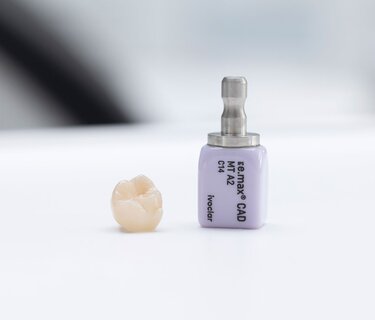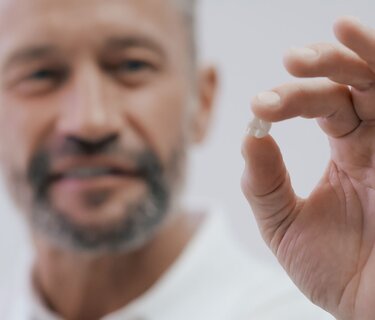Glass-ceramic blocks have proven efficient for the fabrication of esthetic restorations in dental practice. The lithium disilicate blocks are highly suitable for both esthetically demanding and durable restorations. Typical use cases include single tooth restorations (crowns, inlays, veneers and onlays), 3-unit bridges (up to the second premolar) as well as abutments or abutment crowns.
The base material for glass-ceramics is a glassy phase with an embedded crystalline phase. Simply put: The more reinforcement crystals the glassy phase contains, the better its mechanical properties (e.g. flexural strength and fracture toughness). Reinforced glass-ceramics (lithium silicate ceramics, including lithium disilicate ceramics) are used for the CAD/CAM fabrication of restorations. This group of materials comprises various materials. To make the best decision when using these materials in clinical practice, it is essential to have knowledge about their optical and mechanical properties.

For evaluating CAD/CAM glass-ceramic materials, the differences in flexural strength and fracture toughness are highly relevant.
Flexural strength (measured in megapascals, MPa) is considered the most important parameter for the load-bearing capacities of a material. The value indicates the force required to cause complete fracture. Therefore, flexural strength is a crucial parameter in defining the application areas of glass-ceramic materials as well as determining the bonding options. The rule is:
- The higher the flexural strength, the more durable the restoration.
- The key factor for a material’s application area (e.g. a crown or bridge) is its flexural strength. The more stable a material is, the wider the possible restoration span (manufacturers’ specifications need to be observed).
Fracture toughness – also called crack growth resistance or crack toughness (measured in MPa m1/2) – describes a material’s resistance to the propagation of cracks. This value indicates the level of force at which cracks in the material will start to propagate and also affects which bonding method may be used. The rule is:
- The higher the fracture toughness, the lower the likelihood of crack propagation in the material in question.
- High fracture toughness is an indicator for better clinical long-term performance.
Therefore, from a clinical perspective, fracture toughness (in MPa m1/2) is a very important value for selecting the appropriate glass-ceramic material for a dental restoration.
Note: A high flexural strength (> 300 MPa) combined with a fracture toughness of more than 2.0 MPa m1/2 are the key material requirements to ensure the material performs well with the different bonding options available. If either of these values is lower, adhesive cementation must be chosen. However, if the values are higher than those specified above, users have the option of adhesive, self-adhesive or conventional cementation in conjunction with retentive preparations.
IPS e.max CAD has a high flexural strength of 530 MPa[1]. This is well above the standard for glass-ceramic materials. For conventional applications of reinforced glass-ceramics, flexural strength values of at least 300 MPa are required. With a flexural strength of 500 MPa or more, it is possible to fabricate 3-unit posterior bridges.

The original lithium disilicate glass-ceramic combines the highest esthetic standards with an efficient workflow and excellent flexural strength and fracture toughness. This is the result of nearly two decades of experience, sound expertise and continuous development. And this is precisely why dentists and dental technicians worldwide place such high trust in the original CAD/CAM ceramic material IPS e.max CAD.
Scientifically documented results prove the clinical long-term success of IPS e.max CAD. Hardly any other dental material demonstrates such clinical reliability. Over a ten-year period, posterior crows made of IPS e.max CAD show a survival rate of 97.2%.[3]
In-vivo studies by renowned experts confirm the very good clinical quality of the restorations and the durability of the material. Long-term studies spanning 8, 10, and even 15 years speak for themselves.
[1] Mean biaxial flexural strength; result after more than 10 years of ongoing quality testing, R&D Ivoclar, Schaan, Liechtenstein.
[2] Hill T, Tysowsky G, AADR/CADR Annual Meeting: 1672, 2016.
[3] The survival rate of monolithic IPS e.max CAD posterior crowns was evaluated using the Kaplan-Meier method. The failure rate refers to technical failures such as fractures and chipping, R&D Ivoclar, Schaan, Liechtenstein.